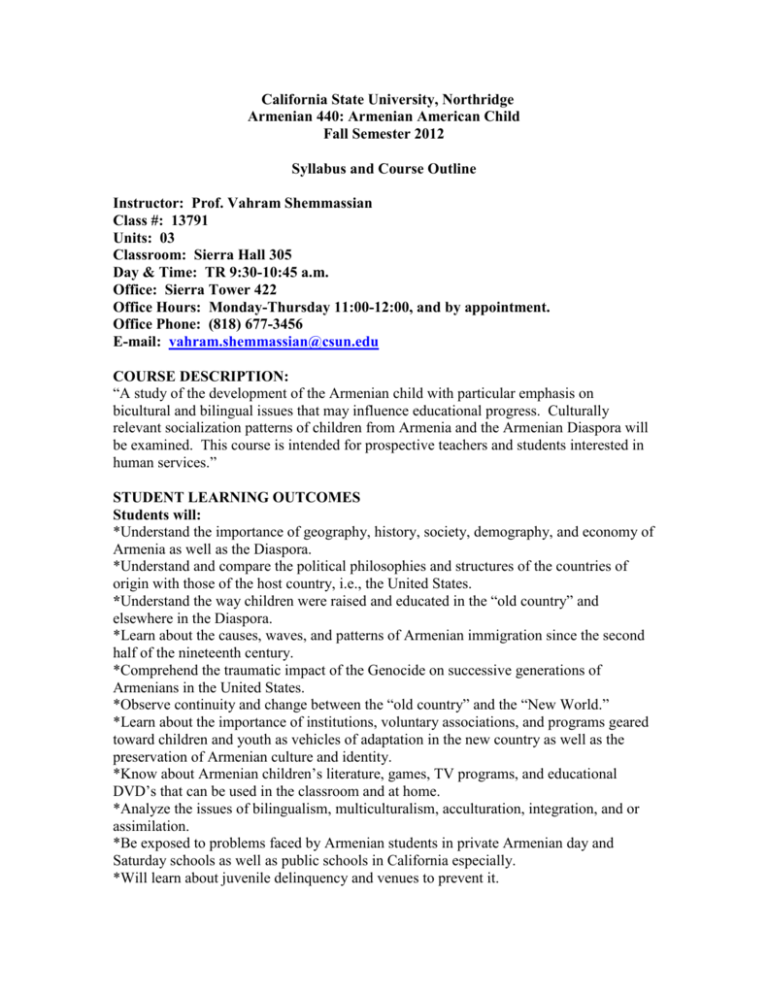ARMN 440 - California State University, Northridge
advertisement

California State University, Northridge Armenian 440: Armenian American Child Fall Semester 2012 Syllabus and Course Outline Instructor: Prof. Vahram Shemmassian Class #: 13791 Units: 03 Classroom: Sierra Hall 305 Day & Time: TR 9:30-10:45 a.m. Office: Sierra Tower 422 Office Hours: Monday-Thursday 11:00-12:00, and by appointment. Office Phone: (818) 677-3456 E-mail: vahram.shemmassian@csun.edu COURSE DESCRIPTION: “A study of the development of the Armenian child with particular emphasis on bicultural and bilingual issues that may influence educational progress. Culturally relevant socialization patterns of children from Armenia and the Armenian Diaspora will be examined. This course is intended for prospective teachers and students interested in human services.” STUDENT LEARNING OUTCOMES Students will: *Understand the importance of geography, history, society, demography, and economy of Armenia as well as the Diaspora. *Understand and compare the political philosophies and structures of the countries of origin with those of the host country, i.e., the United States. *Understand the way children were raised and educated in the “old country” and elsewhere in the Diaspora. *Learn about the causes, waves, and patterns of Armenian immigration since the second half of the nineteenth century. *Comprehend the traumatic impact of the Genocide on successive generations of Armenians in the United States. *Observe continuity and change between the “old country” and the “New World.” *Learn about the importance of institutions, voluntary associations, and programs geared toward children and youth as vehicles of adaptation in the new country as well as the preservation of Armenian culture and identity. *Know about Armenian children’s literature, games, TV programs, and educational DVD’s that can be used in the classroom and at home. *Analyze the issues of bilingualism, multiculturalism, acculturation, integration, and or assimilation. *Be exposed to problems faced by Armenian students in private Armenian day and Saturday schools as well as public schools in California especially. *Will learn about juvenile delinquency and venues to prevent it. *Be acquainted with the ways Armenian parents react to special cases that their children may have, and the existence of certain organizations that are established to assist in solving such problems. ASSESSMENT TOOLS/METHODS *Tests *Term Paper. *Class presentation TEXTBOOK: Anny Bakalian, Armenian Americans: From Being to Feeling Armenian. New Brunswick (USA) and London (UK): Transaction Publishers, 1993. Although particular sections are assigned pertaining to the topics discussed, students are encouraged to read the entire book. BOOKSTORES: Matador Abril (818) 243-4112 Sardarabad (818) 500-0790 METHODS OF EVALUATION: 1. Test 1 30% 2. Test 2 30% 3. Paper 30% The paper must be 5-6 pages long (excluding title page), typewritten, double space, font size 12, with a bibliography of a minimum of 3 sources. References should follow the MLA system. Plagiarism will not be tolerated. 4. Class Presentation 10% GRADING SCALE: A= 95-100 A-= 90-94 B+= 87-89 B= 84-86 B-= 80-83 C+= 77-79 C= 74-76 C-= 70-73 D+= 67-69 D= 64-66 D-= 60-63 F= 59 and below ATTENDANCE & ASSIGNMENTS: Students are required to attend each and every session and be on time. A full grade will be lowered from the semester grade for three unexcused absences as per MCLL departmental rules. A full grade will also be lowered for late submission of term paper. CONDUCT AND WORK ETHICS: Please refer to the 2012-2014 CSUN Catalog, pp. 646-648. NO TEXTING IS ALLOWED IN CLASS. COURSE OUTLINE Week 1, August 28 & 30: Introduction of course, syllabus, requirements, bibliography, paper topics. Week 2, September 4 & 6: Survey of Armenian history, geography, language, culture, and demographics, with emphasis on the 20th and early 21st century. Week 3, September 11 & 13: The Armenian family and children in the “old country,” Soviet Armenia, and the Diaspora. Week 4, September 18 & 20: The Armenian Genocide, the fate and emotional/psychological condition of children; impact of the Genocide on successive generations; how to teach the Armenian Genocide. Reading assignment from textbook, pp. 347-360. September 20: Test 1. Week 5, September 25 & 27: Term paper topics with bibliography are due on September 27 (typewritten and in hard copy). Armenian emigration to the United States; the evolution of Armenian American communities; the Armenian American family. Reading assignment from textbook, pp. 179-244 and 368-388. Week 6, October 2 & 4: Armenian students in Day Schools, Saturday Schools, and Sunday Schools; Armenian students in public schools. Reading assignment from textbook, pp. 268-290. Week 7, October 9 & 11: The usage and preservation of the Armenian language in a multicultural setting; bilingualism. Reading assignment, pp. 251-268. Week 8: October 16 & 18: Armenian children’s literature, authors, analysis, storytelling. Week 9, October 23 & 25: Armenian children’s music, magazines, games. Reading assignment, pp. 298-312. October 25: Test 2. Week 10, October 30 & November 1: Papers are due on November 1. Youth organizations and camps as vehicles for the preservation of ethnic identity in a multicultural society; juvenile delinquency. Week 11, November 6 & 8: Youth organizations and camps as vehicles for the preservation of ethnic identity in a multicultural society; juvenile delinquency (cont.) Week 12, November 13 & 15: Mental health, counseling, community resources. Week 13, November 20 & 22 (Thanksgiving Recess, no class): Class presentations. Week 14, November 27 & 29: Class presentations Week 15, December 4 & 6: Class presentations.







